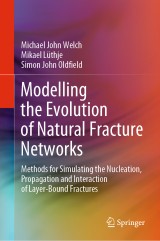Details

Modelling the Evolution of Natural Fracture Networks
Methods for Simulating the Nucleation, Propagation and Interaction of Layer-Bound Fractures|
CHF 165.50 |
|
| Verlag: | Springer |
| Format: | |
| Veröffentl.: | 18.09.2020 |
| ISBN/EAN: | 9783030524142 |
| Sprache: | englisch |
Dieses eBook enthält ein Wasserzeichen.
Beschreibungen
<div>This book presents and describes an innovative method to simulate the growth of natural fractural networks in different geological environments, based on their geological history and fundamental geomechanical principles.</div><div><br></div><div>The book develops techniques to simulate the growth and interaction of large populations of layer-bound fracture directly, based on linear elastic fracture mechanics and subcritical propagation theory. It demonstrates how to use these techniques to model the nucleation, propagation and interaction of layer-bound fractures in different orientations around large scale geological structures, based on the geological history of the structures. It also explains how to use these techniques to build more accurate discrete fracture network (DFN) models at a reasonable computational cost. These models can explain many of the properties of natural fracture networks observed in outcrops, using actual outcrop examples. Finally, the book demonstrates how it can be incorporated into flow modelling workflows using subsurface examples from the hydrocarbon and geothermal industries.</div><div><br></div><div><i>Modelling the Evolution of Natural Fracture Networks</i> will be of interest to anyone curious about understanding and predicting the evolution of complex natural fracture networks across large geological structures. It will be helpful to those modelling fluid flow through fractures, or the geomechanical impact of fracture networks, in the hydrocarbon, geothermal, CO2 sequestration, groundwater and engineering industries.</div>
<p>Introduction.- Conceptual Model.- Modelling Microfractures.- Modelling Macrofractures.- Active and Static Fractures.- Elastic Moduli and Stress.- Controls on Fracture Evolution.- Some Outcrop Examples.- Application to the Subsurface.- Conclusions and Further Work.</p>
<div>Since completing his PhD at Birmingham University in 1997, Michael Welch has worked as an applied structural geologist in various consultancies and academic positions. His focus has always been on applied research in structural geology, developing new tools and techniques to solve specific problems, and working with industry to apply those techniques. This work has aimed to understanding and predicting the occurrence and effects of fractures and faults in the subsurface, mostly, but not exclusively, in the hydrocarbon industry. He has presented much of this work in publications and international conference presentations. </div><div><br></div><div>Mikael Lüthje did his PhD in geophysics and applied mathematics at Cambridge University, Technical University of Denmark and UCL in 2005. He has since then worked within academia, R&D and in the industry mostly with fractured reservoirs. He has also worked extensively with climate research, CO2 sequestration and fluid flow modelling.</div><div><br></div><div>Simon Oldfield is a structural geologist with a background in geological modelling and model validation. Having previously worked in the mining and hydrocarbon industries, he undertook his PhD at the University of Leeds investigating the uncertainty of how seismic imaging represents different structural geometries observed in the field. Since 2019, he has worked with DHRTC calibrating and validating fracture modelling outputs against natural outcrops and considering the implications for subsurface fluid flow.</div><div><br></div><div>The Danish Hydrocarbon Research and Technology Centre, based at the Technical University of Denmark, was set up in 2015 with funding from the hydrocarbon industry with a remit to carry out research to benefit the Danish offshore hydrocarbon industry. For the past 3 years, Michael and Mikael have been working on this project to develop new techniques to simulate natural fracture networks, for use in building improved fluid flow models of hydrocarbon fields. They have been working closely with Total E&P Denmark to apply these techniques to Danish offshore oil and gas fields, and have also applied them to several outcrops and a geothermal prospect. The techniques have potential applications in all fractured reservoirs and aquifers across industries including hydrocarbon extraction, geothermal energy, CO2 sequestration and underground storage.</div>
<div>This book presents and describes an innovative method to simulate the growth of natural fractural networks in different geological environments, based on their geological history and fundamental geomechanical principles.</div><div><br></div><div>The book develops techniques to simulate the growth and interaction of large populations of layer-bound fracture directly, based on linear elastic fracture mechanics and subcritical propagation theory. It demonstrates how to use these techniques to model the nucleation, propagation and interaction of layer-bound fractures in different orientations around large scale geological structures, based on the geological history of the structures. It also explains how to use these techniques to build more accurate discrete fracture network (DFN) models at a reasonable computational cost. These models can explain many of the properties of natural fracture networks observed in outcrops, using actual outcrop examples. Finally, the book demonstrates how it can be incorporated into flow modelling workflows using subsurface examples from the hydrocarbon and geothermal industries.</div><div><br></div><div><i>Modelling the Evolution of Natural Fracture Networks </i>will be of interest to anyone curious about understanding and predicting the evolution of complex natural fracture networks across large geological structures. It will be helpful to those modelling fluid flow through fractures, or the geomechanical impact of fracture networks, in the hydrocarbon, geothermal, CO2 sequestration, groundwater and engineering industries.</div>
Introduces an innovative method to stimulate the growth of natural fractural networks Showcases numerous applications of the modelling techniques described Explains the applicability to hydrocarbon, geothermal, groundwater and engineering industries

















